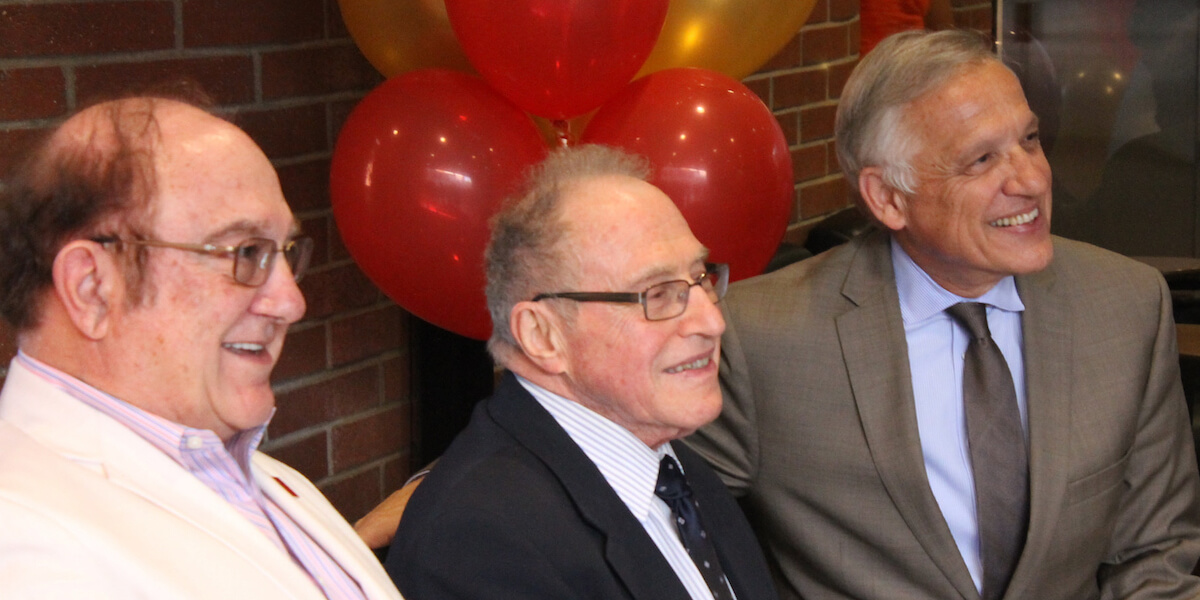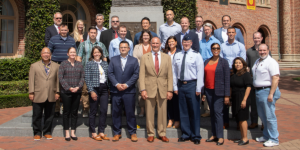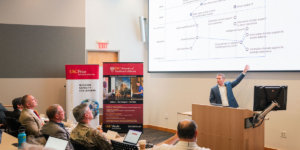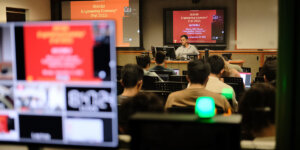
USC Viterbi alumnus Kenneth Hekimian, his mentor Howard Laitin, and USC Viterbi Dean Yannis C. Yortsos (Left to Right) Photo/Valentina Suarez
To Kenneth Hekimian, Ph.D. ISE ’72, Howard Laitin is more than just his former thesis advisor at USC Viterbi; he is an inspiration, longtime friend of more than 45 years, and an intellectual giant.
On Friday, Feb. 2 before his and his mentor’s family and friends, Hekimian paid homage to Laitin by donating a beautiful bench in his name.
“Howard’s a mensch, somebody who when he shows an interest in someone really helps them,” said Hekimian, the principal in charge at HVN Environmental Service Company in Torrance. “He’s showed me grace. Not only has he given me his time, but he’s also given me his energy. When things weren’t going well, he’d say: ‘Stay in there, kid.’”
Laitin called his former student Hekimian “very smart, very hard working and very sincere.” He said Hekimian’s gesture touched him deeply.
Added USC Viterbi Dean Yannis C. Yortsos: “Ken’s generous gift has allowed us to honor Howard [Laitin] and the legacy of a man who has had an incalculable impact upon so many students.”
The Laitin bench resides in the Howard Hughes Electrical Engineering Center adjacent to the late Sol Golomb’s relief. Its location couldn’t be more perfect.
The 86-year-old Laitin spent more than 30 years at Hughes Aircraft, eventually rising to the position of chief scientist. During his illustrious career, he played a crucial role in the development of the TOW missile and the Maverick air-to-ground infrared guided missile. Additionally, Laitin worked as an analyst at RAND Corp. from 1958 to 1961 and served on task forces that led to the creation of the state of California’s solid waste and hazardous waste control programs; the US Department of Transportation and the US Environmental Protection Agency. A lieutenant colonel, Laitin advised the executive offices of nearly every president from John F. Kennedy to Barack Obama.
Laitin and the late Golomb, the legendary, longtime USC Viterbi electrical engineering professor whose pioneering work in communications technology helped spark the digital communications revolution, had a deep friendship of more than 60 years. The pair met, in 1952, as students at Harvard University, where they lived in the same dorm. Laitin recalls four years of intensive academic and social interaction with Golomb.
As a measure of Golomb’s closeness to Laitin, Dr. Beatrice Golomb, his daughter, attended the bench dedication ceremony. Beatrice Golomb, a professor of medicine at UC San Diego who has known Laitin her entire life, has been documenting some of his and her late father’s joint activities, such as applying the mathematical theory of games to real-world problems; exploring Boston’s ethnic restaurants; attending Harvard football, ice hockey and baseball games.
Golomb, a recipient of the National Medal of Science, passed away in 2016.
Also attending was, Najm Meshkati, a professor of civil and environmental engineering, industrial systems engineering and international relations. In 1977, Meshkati took Laitin’s course on systems engineering methodology. The two have been friends ever since.
“Dr. Laitin is, in my judgement, one of the smartest people that I have ever met and certainly one of the most remarkable professors,” Meshkati said. “I think he is a quintessential, unrivaled systems thinker and scholar. It was a privilege to be his student.”
Hekimian would surely agree.
“It’s an honor to be associated with these geniuses, Howard Laitin and Sol Golomb,” said Hekimian, adding that Golomb also served as his thesis advisor.
Hekimian, prior to beginning his graduate studies at USC in 1966, worked at AVCO Corp. in Boston, coming up with the design for the nosecone for ballistic missile systems. Hekimian later had a stint at the Aerospace Corporation’s San Bernardino’s office, where he helped develop the “bus system” to deploy multiple nuclear warheads.
While at USC, Hekimian simultaneously worked at TRW. Although a part-time student, Hekimian, said he was fully committed to Troy. Building on his systems engineering environmental term project, Hekimian helped, in the late 1960s to obtain a $500,000 unrestricted teaching and research grant to USC engineering. Hekimian collaborated with Laitin and Golomb in securing the federal money.
Reflecting on his longstanding connection to USC, Laitin, Golomb and others, Hekimian called the bench dedication ceremony “a wonderful, very nice affair – a day I’ll remember.”
Hekimian added that he encourages other Trojans to support USC Viterbi. “I would love my fellow alums to recognize their professors’ legacy in a debt that cannot be repaid but can be paid forward,” he said.
Published on March 9th, 2018
Last updated on September 19th, 2021











